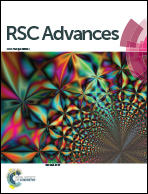Deciphering the mechanism and structural features of polysorbate 80 during adsorption on PLGA nanoparticles by attenuated total reflectance – Fourier transform infrared spectroscopy†
Abstract
Polysorbate 80 coated nanoparticles have been studied extensively for delivery of many bioactive molecules to the brain for diagnosis and treatment of different neurological disorders. The adsorption mechanism of polysorbate 80 on nanoparticles is not known due to a lack of suitable techniques for quantification at low concentrations. Here we report the probable mechanism of polysorbate 80 adsorption on poly-D,L-lactide-co-glycolide (PLGA) nanoparticles using a novel extraction procedure coupled with a highly sensitive attenuated total reflectance-Fourier transform infrared (ATR-FTIR) spectroscopic method. Both methods facilitated the characterization and quantification of extracted surfactant at the nanogram level. Adsorption isotherm modeling reveals that polysorbate 80 follows a physisorption process (ΔG = 38 kJ Mol−1) and forms a monolayer on the nanoparticle surface. Thermal analysis and X-ray photoelectron spectroscopy (XPS) further support polysorbate 80 coating and surface coverage on PLGA nanoparticles. Real-time ATR-FTIR analysis shows that polysorbate 80 interacts with nanoparticles through the ester group (–C![[double bond, length as m-dash]](https://www.rsc.org/images/entities/char_e001.gif) O) and acyl chain (–CH2) during the adsorption. The extent and direction of band shifts in real-time FTIR experiments suggest that the acyl chain of polysorbate 80 micelles loses its ordered structure and becomes flexible with a higher gauche/trans conformer ratio. Reduction in the degree of hydration of the ester group indicates an increase in hydrophobic interactions in the presence of PLGA nanoparticles. The results of FTIR analysis states that polysorbate 80 acquires a flat structure on the nanoparticle surface. This study on polysorbate 80 quantification and adsorption with ATR-FTIR spectroscopy can be extended to other non-ionic surfactants which will ultimately help in determination of biological fate of surfactant coated nanoparticles under in vivo conditions.
O) and acyl chain (–CH2) during the adsorption. The extent and direction of band shifts in real-time FTIR experiments suggest that the acyl chain of polysorbate 80 micelles loses its ordered structure and becomes flexible with a higher gauche/trans conformer ratio. Reduction in the degree of hydration of the ester group indicates an increase in hydrophobic interactions in the presence of PLGA nanoparticles. The results of FTIR analysis states that polysorbate 80 acquires a flat structure on the nanoparticle surface. This study on polysorbate 80 quantification and adsorption with ATR-FTIR spectroscopy can be extended to other non-ionic surfactants which will ultimately help in determination of biological fate of surfactant coated nanoparticles under in vivo conditions.


 Please wait while we load your content...
Please wait while we load your content...